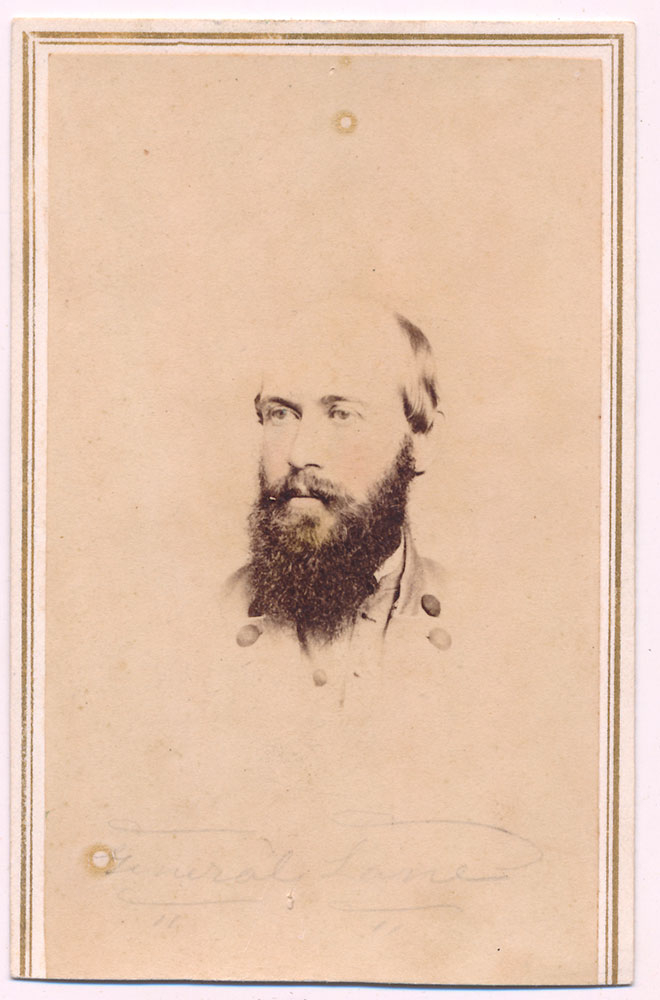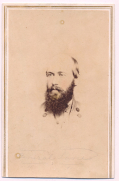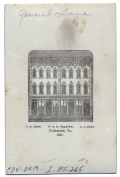site search
online catalog
CDV BUST VIEW OF CS GEN. JAMES H. LANE – 1ST NORTH CAROLINA, 28TH NORTH CAROLINA; THREE TIMES WOUNDED IN ACTION

$1,250.00
Quantity Available: 1
Item Code: 846-575
Shipping: Determined by Method & Location of buyer
To Order:
Call 717-334-0347,
Fax 717-334-5016, or E-mail
Born July 28, 1833, in Mathews County, Virginia, and educated by tutors and private schools, in 1851 Lane entered the Virginia Military Institute where Stonewall Jackson was one of his instructors. He graduated second in Tactics in the class of 1854, received a Masters degree in Science in 1857 from the University of Virginia, and did some brief engineering work on a hydrographic survey of the York River, following which he was Assistant Professor of Mathematics and Assistant Professor of Tactics back at VMI, then Professor of Mathematics and Instructor of Tactics at the State Seminary of Florida at Tallahassee, and lastly Professor of Natural Philosophy and Instructor of Tactics at the NC Military Institute at Charlotte when the war broke out.
As one of the three senior officers in that institute, he became a field officer in the 1st North Carolina, along with D.H. Hill as Colonel. The unit was composed of companies of the uniformed militia who volunteered on April 17, 1861, and were organized into a regiment by four successive orders from the state Adjutant General’s office issued from April 19 through May 16. Lane officially entered state service on April 24 and was recorded as joined for duty and enrolled on April 28. He acted as drill instructor for the companies in camp at Raleigh, and when the regiment was officially organized on May 9 and mustered into state service for six months on May 13, he was commissioned its Major. They moved to Virginia a week later, were assigned to the Peninsula and posted at Big Bethel Church, near Fort Monroe, where they repulsed poorly coordinated Federal attacks from Hampton and Newport on June 10, inflicting some 76 casualties at a cost of 1 killed and 7 wounded, earning the nickname of the “The Bethel Regiment.” Interestingly, since North Carolina had not seceded of joined the Confederacy when the regiment was organized, they were serving as “allies” of Virginia, and were not formally mustered into Confederate service until August 31, and then only for the remaining two months of their service, which would expire on November 12. D.H. Hill was promoted Brigadier General as a result of the victory at Big Bethel, widely taken as portent for future success and Southern independence, leading to new elections, with Lane receiving a “complimentary vote” for Colonel, and “near unanimous” votes for Lieutenant Colonel.
It was thus as a token of respect and a going-away gift that he received a sword from his old regiment with his new rank on it. The presentation must date after notice was received by Lane of his election as Colonel by the 28th North Carolina on Sept. 21, 1861, the same day that regiment was officially organized. Lane formally accepted the offer on Sept. 26 and the Sept. 21 – Oct. 31, 1861, muster rolls of the 28th NC list him as present, so the presentation and his departure from the 1st Regiment likely took place in that window. His official appointment as Colonel of the 28th Regiment was Nov. 1, as was the election of his successor in the 1st Regiment, with that unit encamped in and around Yorktown, where the presentation likely took place, awaiting muster out at Richmond.
Lane certainly carried the sword from his early service in fighting in the Department of North Carolina in December 1861 when Union forces under Foster forced Confederates out of Kinston, and after the regiment moved to Virginia in May, having reorganized in April to serve “for the war,” which they proudly noted was before imposition of the Conscription Act. In Virgnia, as part of Branch’s brigade, they were assigned to A.P. Hill’s division, and served under Stonewall Jackson through the Seven Days Battles, the battle of Cedar Mountain and the Campaign of Second Manassas, including at Manassas Junction, the main battle itself, and the follow-up fighting at Chantilly, throughout the Antietam Campaign, in which the regiment, as part of A.P. Hill’s Light Division, arrived in time on September 17 to repulse McClellan’s attack on the Confederate right (and where Lane took brigade command,) and through Fredericksburg, where as a Brigadier General he again held a critical position, helping to stem a Union breakthrough on the Confederate right. The same 1894 newspaper article recording the presentation of this sword, mentions another sword, saddle and bridle, along with a general’s sash, presented to him, this time by the 28th Regiment after his promotion to Brigadier General as of Nov. 6, 1862, but that presentation took place after they went into winter camp at Moss Neck following the Battle of Fredericksburg. Even thereafter it is possible he retained this sword for field use, with a more elegant general’s sword reserved for full dress.
Without positive testimony we cannot be sure in which of Lane’s many engagements this occurred or if it happened at the same time as one of his wounds since he was under heavy enemy fire numerous times. He suffered three wounds, two while serving as Colonel and certainly carrying this sword: a head wound on June 27, 1862, at Gaines Mill, and an ugly wound to the face three days later at Glendale on June 30. Neither were enough to force him off the field. On the first occasion he asked a sergeant whether his scalp was cut: the sergeant reassured him it was just “scorched a little.” The second was a more serious wound to the face. Jefferson Davis, visiting the front, asked the wounded officer with his face swaddled in bandages if he wanted a carriage ride to the hospital. Not recognizing the Confederate President, Lane told him to, “mind his own business.” He was also seriously wounded in the groin in 1864 at Cold Harbor, perhaps by projectile deflected by his sword hilt, but he was under fire many times and newspaper accounts even mention his horse being shot under him in Pickett’s Charge, making a fall upon it equally possible. In any case, this is the field sword of an extremely active officer who was under heavy fire in many critical positions during the war.
Lane was said to be of “of only average height,” which seems to have been a polite euphemism, since he was referred to as the “Little General.” In any case, he seems to have been short of stature, but long on fight. It shows in a July 1861 Special Requisition where, impatient with army paperwork, he noted in the formal prose necessary on a requisition for a simple pair of hinges with screws, and a lock, that, “I certify that the above requisition is correct & that the articles specified are absolutely necessary for the public service rendered so by the following circumstances / To swing & fasten a door to a powder magazine in the first Regt NCV to keep ammunition in to kill ‘Yankees’ with.” A more concrete example would be his aggressive attack on a Union patrol within sight of Union-held Hampton, VA, on June 8, 1861, that was said by D.H. Hill to have provoked the Battle of Big Bethel, regarded by many as the first land battle of the war and a highly-touted Confederate victory two days later.
This was mixed with a professional military competence from his education at VMI, with Jackson as one of his instructors, that likely explains his repeated deployment at critical spots on the battlefield. Under his command, the 28th NC helped cover the retreat from New Bern to Kinston, and he was credited with executing a tricky withdrawal from Hanover Court House in the Seven Days Battles, a campaign in which the regiment lost some 12 killed and 146 wounded out of just 480 officers and men. In the retreat from Antietam he commanded the brigade in rearguard fighting at Shepherdstown on Sept. 20 that drove Union pursuers back to and across the Potomac after Pendleton botched the holding action. At Gettysburg on July 1 he led the right flank of Pender’s advance dealing with Union cavalry on his right and infantry to his front. Only July 3 in Pickett’s Charge he led his brigade to forefront of the Confederate advance, holding the left against Union infantry on his flank while artillery raked him from the front and was among the last to withdraw. At Falling Waters on July 14, again acting as the rearguard, he commanded Pender’s division and protected Lee’s pontoon bridge as both Heth and Pettigrew delivered a mixed performance against Union cavalry. At Spottsylvania in 1864 he played a critical role in stabilizing the right flank of the mule-shoe salient on May 12 after Hancock had overrun the center, even counterattacking the left of Burnside’s 9th Corps as it attacked that portion of the line, though losing some 470 men of his brigade, on top of roughly 400 he had lost days earlier at the Wilderness. He was wounded seriously at Cold Harbor on June 3, 1864, but resumed command on Aug. 29, and was later given temporary command of the division. He also played a central role in the defense of Fort Gregg at Petersburg on April 2, 1865, which bought enough time for Lee to bring the army out of the city’s defenses. He had four regiments with him at Appomattox, surrendering 56 officers and 484 men, a number increased by the return to the brigade of “non arms bearing men.” His fighting force had been much less and he had taken casualties as recently as Farmville, just days earlier.
All of this service was on top of much other hard fighting. At Cedar Mountain on Aug. 9, his regiment lost 3 killed and 26 wounded. At Manassas Junction on Aug. 27, and Second Manassas then next day they were under heavy artillery fire. They fought on the extreme left of Jackson’s line on Aug. 29, and were under artillery fire and engaged in skirmishing on Aug. 30, losing 5 killed and 45 wounded. On September 1, they fought in the rain at Chantilly, crossed the Potomac on Sept. 5, climbed cliffs at Harpers Ferry on the night of Sept. 14, and on Sept. 17 reached the battlefield in mid-afternoon in time to thwart Burnside’s assault on the Confederate right and hand McClellan a stalemate. At Fredericksburg, along the railroad on the Confederate right his brigade was flanked on the right, but drove back two Union attacks until compelled to pull back, and then took part in the Confederate counterattack. At Chancellorsville, Jackson pushed Lane’s brigade forward in column on and then astride the Orange Turnpike in his devastating flank attack, with the ironic result that it some of Lane’s men who mortally wounded his old teacher and military instructor. It was not the only price Lane paid: he lost two brothers during the war.
Lane’s postwar career was largely a return to academia, though not without a military bent. He taught in private schools in Richmond, Va., and in Concord and Wilmington, N.C. From 1872 to 1880 he was professor of natural philosophy and commandant at Virginia Agricultural and Mechanical College (later Virginia Polytechnic Institute). He returned to engineering as a profession briefly as superintendent of the Virginia Mining and Manufacturing Company, but in 1881-82 was back in teaching as professor of mathematics at the Missouri School of Mines and Metallurgy, followed by an appointment as professor of civil engineering and commandant, and then as professor of engineering and drawing, at the Alabama Agricultural and Mechanical College, called successively the Alabama Polytechnic Institute and later Auburn University, where he taught for twenty-five years, receiving also several honorary degrees from other institutions, and retiring as professor emeritus in June 1907, three months before his death, and where most of his extensive papers reside. [cla][ph:L]
~~~~~~~~~~~~~~~~~~~~~~~~~~~~~~~~~~~
THIS ITEM, AS WITH ALL OTHER ITEMS AVAILABLE ON OUR WEB SITE,
MAY BE PURCHASED THROUGH OUR LAYAWAY PROGRAM.
CLICK HERE FOR OUR POLICIES AND TERMS.
THANK YOU!
Inquire About CDV BUST VIEW OF CS GEN. JAMES H. LANE – 1ST NORTH CAROLINA, 28TH NORTH CAROLINA; THREE TIMES WOUNDED IN ACTION
For inquiries, please email us at [email protected]
Most Popular
Historical Firearms Stolen From The National Civil War Museum In Harrisburg, Pa »
Theft From Gravesite Of Gen. John Reynolds »
Selection Of Unframed Prints By Don Troiani »
Fine Condition Brass Infantry Bugle Insignia »
British Imported, Confederate Used Bayonet »
Scarce New Model 1865 Sharps Still In Percussion Near Factory New »
featured item
“I LIKE YOUR STYLE” THE REGIMENTAL STANDARD OF THE 12th ILLINOIS CAVALRY: GAMBLE’S BRIGADE UNDER BUFORD ON JULY 1 AT GETTYSBURG
We can’t think of a more flamboyant, devil-may-care motto on a cavalry standard than this one, whose overtly casual nature no doubt intentionally contrasts with their combat and fighting record. Placed in quotation marks, this was taken from the… (1179-033). Learn More »
site search
Upcoming Events
May 16 - 18: N-SSA Spring Nationals, Fort Shenandoah, Winchester, VA Learn More »




